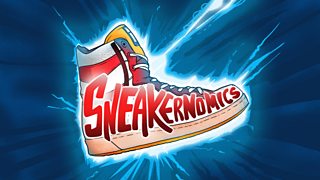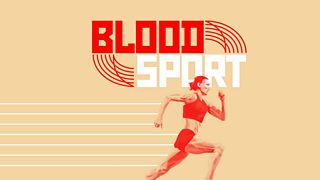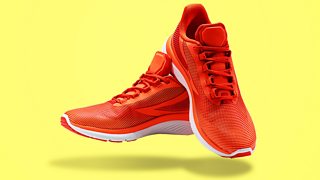The sibling rivalry that changed sport for ever
In the 91�ȱ� Radio 4 podcast Sneakernomics, we hear the incredible true stories behind trainers – the shoes that changed the world. Here, the podcast’s writer and presenter Nicholas Smith tells one of those stories: the tale of the bitter rivalry that changed the sports industry for ever.
Shakespeare or shoes?
It seems like something that would’ve once played long ago at the Globe theatre: two feuding brothers first divide apart their family, and then their town. The sibling rivalry continues to the next generation until the whole matter is resolved, almost in comical fashion by playing a game.
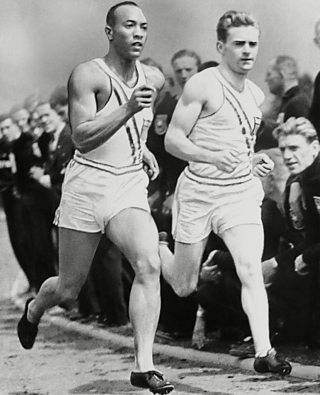
But it’s not the Bard, it’s Bavarian; not Shakespeare, but shoes.
You might not have heard of the German brothers Adolf (Adi) and Rudolf (Rudi) Dassler, but you have heard of the companies they founded: Adidas and Puma.
So how did two brothers, both alike in ambition, in fair Herzogenaurach, where we lay our scene, end up as star-crossed competitors?
Greatness thrust upon them
Don’t feel bad if you’ve never heard of Herzogenaurach, the place where Adi and Rudi were from. When they formed the Dassler Brothers Sports Shoe Factory in 1924, “Herzo” was just another tiny town in southern Germany.
That would all start to change as the brothers churned out running and football shoes. The more outgoing Rudi ran the sales side while the more reserved Adi made the shoes.
“He started experimenting manufacturing shoes in his mother's laundry room,” said Sigi Dassler, Adi’s youngest daughter, in an interview for Sneakernomics. “He used all kinds of raw material he could find, including bread bags, and his father helped him to organise this, as well build machines in order to get the business started.”
A friendship with the German Olympic athletic coach gave the brothers access to a range of new athletes. A few months after Adolf Hitler rose to power, both Dassler brothers joined the Nazi Party in 1933, in an effort to maintain their business.
When the 1936 Olympics were held in Berlin, the brothers were in a position to offer American sprinter Jesse Owens, who would go on to win four gold medals, a pair of his own Dassler shoes.
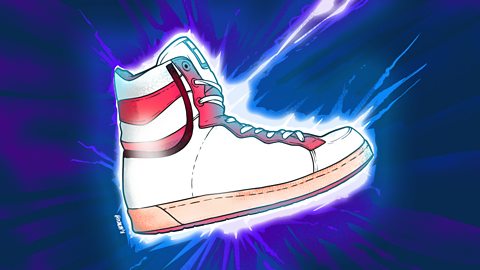
The shoes that changed the world
91�ȱ� Ideas looks at the impact trainers have had on our lives and the environment.
Let slip the dogs of sport
As the brothers’ business grew, so too did the distance between the social Rudi and the quiet Adi, who preferred the solitude of the workshop to the liveliness of a sales call. As sometimes happens with family members working together, differing personalities can pull a business in different directions. No one can quite pinpoint the exact breaking point between the brothers, but the devastation of WWII and the accusations flying from both sides certainly didn’t help the relationship. Adi and Rudi split for good in 1948, each taking a stable of employees with them. Adi ended up founding Adidas on one side of the Aurach River running through Herzo, while Rudi started Puma on the other side.

Adidas and Puma entered into the “Pelé Pact,” where both brands informally agreed not to sign the Brazilian forward.
As both businesses grew, so did the split among the town. Bakeries, pubs and even tombstone cutters started catering to employees of one side or the other.
Athletes even tried to play one Dassler against the other. In one notable instance, German sprinter Armin Hary wore Pumas to cruise to a 100m gold medal in the 1960 Olympics, but on the medal stand, he wore Adidas. Needless to say, neither brother was fully pleased at the switcheroo.
“We didn't even mention the name, Adidas, actually at home,” Michael Dassler, grandson of Puma founder Rudi, told the 91�ȱ�. “We usually said N.G., for German, nie gehort, never heard of. It's like in Harry Potter… the name Voldemort which is not mentioned.”
All the world’s a football pitch
As Adi and Rudi got older, their sons carried on the family legacy of making sports shoes. Both Horst Dassler (Adi’s son) and Armin Dassler (Rudi’s son) expanded their respective companies, often by undermining their family rival at crucial moments.
Signing top athletes and creating signature shoes were a good way to gain clout among the sports-loving public. Sensing that a bidding war for football superstar Pelé would bankrupt the two brands, Adidas and Puma entered into the “Pelé Pact,” where both brands informally agreed not to sign the Brazilian forward. Yet when Pelé puckishly knelt down to tie his Pumas on camera during the 1970 World Cup, Adidas saw it had been had.
“You know that really fuelled the rivalry even more,” said Sigi Dassler. “I mean, they just show it again, you can’t trust each other, and you can’t trust the Puma people. I don’t know, that’s just me.”
Yet Dassler control of the two companies would not last forever. Adidas was sold to French businessman Bernard Tapie in 1989, not long after Horst Dassler’s untimely death at age 51. That same year, Rudi Dassler’s two sons sold their controlling interest of Puma to private investors.
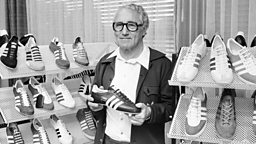
In 2020, Adidas revenues totalled nearly €20 billion, while Puma pulled in about €5 billion.
All’s well that ends well
In 2009, the two companies formally reconciled with a football match. Rather than an Adidas vs. Puma contest to determine a winner, each side featured a blend of employees from each company (even the match ball was co-branded). In the end, the 7-5 score was nothing, if not ceremonial. Not far away, the brothers’ feud plays out for eternity. Adi and Rudi Dassler are buried at opposite sides of Herzogenaurach’s cemetery.
In the end, both brands were able to achieve worldwide success with a presence on football pitches, Formula 1 tracks, and fashionable feet everywhere. In 2020, Adidas revenues totalled nearly €20 billion (£17.15 Billion), while Puma pulled in about €5 billion (£4.3 Billion).
In the history of trainers, the Dasslers were not the only pair of shoe-making brothers to leave their mark on sports, fashion and culture. To hear more stories of sneaker siblings, told by those who were there, listen to Sneakernomics on 91�ȱ� Sounds.
More from Radio 4
-
![]()
Sneakernomics
The story of the mavericks and dreamers who battled to create the world's biggest sports brand.
-
![]()
Bloodsport
The story of the systematic doping of the 2012 and 2014 Olympics by the Russian state.
-
![]()
Gotta Have Sole: How Much Do You Know About Trainers?
How much do you know about the history and impact of all things sneaker?
-
![]()
Tricky
Four people. One topic. No filter. Tricky is a safe space where important conversations happen with no fear of cancellation.
